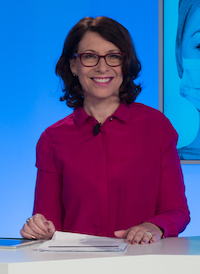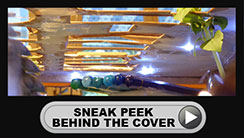
Claire Doole is a former BBC correspondent and international spokeswoman who is passionate about helping people communicate with confidence. Since 2006, she has successfully trained hundreds of professionals in the art of presenting and public speaking, talking to the media, managing communications in a crisis, and writing for the web. In addition, she has coached C-level executives and public figures to give powerful TEDx and TED style talks in Europe and the Middle East. A Swiss and UK national, Claire trains and coaches in French and English.
Claire is also a highly experienced moderator having facilitated panel discussions with government ministers, NGO activists, humanitarians and human rights specialists at major events.

Those who know me would say that I am not one for hyperbole. However the speakers I coached at the UN TEDx PlacedesNationsWomen event in December completely hit the target.
I coached 8 of the 11 speakers at the event, celebrating women’s empowerment.
The speakers had great content and delivery, and kept the audience engaged from start to finish.
Yet, it proved to be a lot of work for all those involved with many lessons learnt. So for those who are planning to organise a TEDx, give a talk or want to become a more impactful public speaker, here are 5 do’s and 5 don’ts from coaching and observing speakers.
Do’s
- Select a speaker fluent in the language of the talk. You have to memorise your TEDx talk, which means it helps to be absolutely fluent in the language. This will also ensure you sound natural and conversational when you deliver it. And a good memory is key!
- Have an inspiring personal story to tell. You have to put yourself in the story for it to resonate with the audience. Many professionals shy away from the personal, preferring to speak about “it” rather than “I”. But this is not a TEDx talk. You have to be prepared to open up in your talk, share your experiences, opinions and values.
- Leave behind your professional presenting style. You are no longer an academic, activist or lawyer, you are now a storyteller. You are not there to share your knowledge, but to persuade the audience your idea has merit. This means getting rid of unnecessary detail. You need to set the context, and what is most important are the individual stories you tell to illustrate your points and the narrative arc of the talk.
- Match your words to your voice and body language. You have to make sure that these three channels of communication are aligned. You need to guide the audience so they understand immediately the emotions (joy, sadness, compassion) you want them to feel. And to do this you have to modulate your speed, pitch and tone. The pause, for example, will let the emotion you want to convey hover in the air so that the audience has time to absorb it.
- Structure with clear signposts. You need to help your audience with short declarative sentences, which tell them where you are going. For example, this is my story of empowerment; I was in denial; or myths and taboos lead to stigma and harmful practices.

A TED talk is all about sharing an inspiring idea. It sounds easy enough, but it is more difficult than you might think.
I speak from experience - having coached speakers for several TEDx events in Geneva and Lausanne and having been called in twice to salvage someone's TED talk within days of the event.
So when I was asked by the UN to coach 9 speakers for their PlacedesNationsWomen event one of the first things I did was to write a guide on what makes a TED talk different from the usual presentation or keynote address.
Here are my tips on drafting a TED talk, based on my experience as a professional public speaker and coach and the wonderful book
"TED Talks - The Official TED Guide to Public Speaking". by the head of TED Chris Anderson.
- Make it personal: As a speaker, talk about an idea that matters deeply to you and transmit the idea and the passion you feel about it to your audience. It has to be an idea worth sharing!
- Know the audience: Think of yourself as a tour guide taking the audience on a journey to a new place. You need to begin where the audience is and steer them clearly and compellingly along the way.
- Stick with your idea: Think of your talk as about an idea rather than an issue. This is particularly important if you are tackling a tough topic where compassion fatigue can easily set in. An issue-based talk leads with morality. An idea based talk leads with curiosity. It says, "isn't this interesting?" rather than "isn't this terrible?" For example, this is an issue: Education for all. An idea would be framed as "Education's potential is transformed if you focus on the amazing (and hilarious) creativity of kids.
- Connect the dots: You need a connecting theme, which ties together each narrative element. It is the idea that you want to construct in the minds of the audience. Can you put this in no more than 15 words?
- Make it memorable: Think about the three points/messages that you want the audience to remember when they leave the room. Studies show people rarely remember more than three points and recall drops dramatically the day after.
The structure
Choose a structure that most powerfully develops your connecting theme. See below some suggestions, which can be mixed and matched over the talk.
- Personal journey: If you are sharing your personal journey then you may want to follow the classic "hero's journey" structure where you have a goal but meet challenges along the way which you overcome and resolve the best you can.
- Persuade: If you want to persuade an audience that the way they currently see the world isn't quite right, you will want to guide them through your argument so that is it plausible. This means breaking down your argument logically into small steps, perhaps even taking the counter position to show that it is flawed.
- Detective: Another way to build a persuasive case is to play detective. You start with a puzzle and then with the audience search for solutions, ruling them out one by one. You invite the audience on a process of discovery and this can work well if you are a scientist or researcher talking about a discovery you have made.
- Aspirational: You may want to speak of the world not as it is, but as it might be. You paint a picture of the alternative future you want and compare and contrast it with the situation today. (Think Martin Luther King, "I have a dream".)

Techniques to make your talk memorable
- Open with impact. Within the first minute, you need to get the audience's attention, make them curious and excited. Here are some ways to start.
1) A surprising statement, fact or statistic.
2) A surprising rhetorical question
3) Show a compelling slide, video or object
4) A personal story or anecdote
You want to tease, but don't give away your punch line. If you are looking to persuade or reveal a discovery you want to build up to your revelation.
- Close with impact.
1) Move from the specific to the broad
2) Call to action - invite people to take action on your idea.
3) Personal commitment - make a commitment of your own.
4) Values and vision - can you turn what you have discussed into an inspiring or hopeful vision of what might be?
5) Narrative symmetry - the human brain likes balance so you may want to link back to your beginning so that the narrative comes full circle.
In my next blogs, I shall take you through how to align delivery and content as well as lessons learnt from my TED journey.
Author's bio
 Claire is a former BBC correspondent and international spokeswoman who is passionate about helping people communicate with confidence. Since 2006, she has successfully trained hundreds of professionals in the art of presenting and public speaking, talking to the media, managing communications in a crisis, and writing for the web. In addition, she has coached C-level executives and public figures to give powerful TEDx and TED style talks in Europe and the Middle East. A Swiss and UK national, Claire trains and coaches in French and English.
Claire is a former BBC correspondent and international spokeswoman who is passionate about helping people communicate with confidence. Since 2006, she has successfully trained hundreds of professionals in the art of presenting and public speaking, talking to the media, managing communications in a crisis, and writing for the web. In addition, she has coached C-level executives and public figures to give powerful TEDx and TED style talks in Europe and the Middle East. A Swiss and UK national, Claire trains and coaches in French and English.
Claire is also a highly experienced moderator having facilitated panel discussions with government ministers, NGO activists, humanitarians and human rights specialists at major events.

Rapport is the foundation of influence and impact. An American psychiatrist and psychologist, Milton Erickson, once said, "With rapport, everything is possible. Without it, nothing is possible."
So what is this magical ingredient in effective communications? It is about being on the same wavelength as someone else so that we feel connected. It often involves having shared values, beliefs or similar life experiences. I know, for example, that I usually instantly connect with someone who is or has been a journalist due to my time at the BBC.
But how do you build rapport with an audience made up of many different individuals? This is vital when you are speaking in public presenting, giving a keynote speech or sitting on a panel at a conference.
Many of the things that you do naturally one-on-one are applicable, such as finding common ground, asking questions and actively listening to what they are saying.
But when you want to build rapport with an audience, you need to use these skills more consciously.
Let me explain by sharing my list of how to do it, based on my experience as a moderator and public speaking coach.
Finding common ground
When you prepare your speech or remarks you need to think about your audience first and foremost. What are their needs, expectations and challenges? Far too often presenters think that communication is a one-way process but to have impact you need to ensure that your message has got across to the audience so that they are not only engaged but also feel, say or think differently as a result of your presentation.

By Claire Doole, Claire Doole Communications
I was at a conference recently where during the Q and A session, the moderator failed to stop a woman from sharing her life experience as a refugee with the audience. Interesting, as it was how she ended up in Oxford from Myanmar, it was not relevant to the subject of the panel.
As the audience became restless with many rolling their eyes, the moderator did try to interrupt and ask for her question. She said she had no question but thought the audience should know about what she went through!
This made me think of how important it is as a moderator or as a presenter that you handle effectively the Q and A session.
Below are some tips based on my experience as a moderator and presenter who trains in both disciplines.
The audience member, who doesn't ask a question, but makes a comment.
- Make it clear before you take a question that you want a question not comments. Take a leaf out of the book of Christiane Amanpour, the doyenne of CNN, when she moderated a panel at the UN in Geneva.
 © Caux Forum 2018
© Caux Forum 2018
By Claire Doole, Claire Doole Communications
Recently, I coached the head of a large Swiss NGO for a series of speeches she is giving at a popular summer forum.
We worked on a structure and delivery that holds the attention of a global audience from different backgrounds - academic, non-governmental, diplomatic and corporate.
What the coaching reminded me of is that the theories on memory recall developed by a German Professor during the last century are still valid today. Namely, the ability of the brain to retain information decreases over time.
Professor Hermann Ebbinghaus developed the "forgetting curve" which shows that the sharpest decline is during the first 20 minutes and then it levels off after 1 day. The speed of the decline depends on a number of factors such as how easy, visual or relevant the information is to retain. However, on average as the graph below shows people only retain 40% after the first day.








